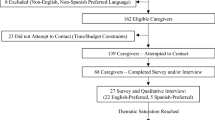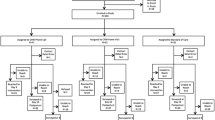Abstract
The HIV Infant Tracking System (HITSystem) is an eHealth intervention to improve early infant diagnosis (EID) through alerts to providers and text messages to mothers. This study explored mothers’ experiences receiving standard and HITSystem-enhanced EID services to assess perceived intervention benefits, acceptability, and opportunities for improvement. This qualitative study was embedded within a cluster-randomized control trial to evaluate the HITSystem at six Kenyan government hospitals (3 intervention, 3 control). We conducted semi-structured interviews with 137 mothers attending EID follow-up visits. Compared to control sites, participants at HITSystem sites described enhanced EID quality; HITSystem-generated texts informed them of result availability and retesting needs, provided cues-to-action for clinic attendance, and engendered opportunities for patient support. They described improved EID efficiency through shorter waiting periods for results and fewer hospital visits. Participants reported high satisfaction with EID and acceptability of text messages; however, modifications to ensure text delivery, increase repeat testing reminders, include low literacy content options, and provide encouraging messages were suggested. These user experience data suggest improvements in EID at HITSystem sites when compared with control sites.
Similar content being viewed by others
References
Country factsheets: Kenya 2017: UNAIDS; 2017. http://www.unaids.org/en/regionscountries/countries/kenya. Accessed 21 June 2019.
National AIDS and STI Control Programme (NASCOP). Guidelines for prevention of mother to child transmission (PMTCT) of HIV/AIDS in Kenya, Fourth Edition. 2012. https://www.faces-kenya.org/wp-content/uploads/2012/11/Guidelines-for-PMTCT-of-HIVAIDS-in-Kenya-1_2012.pdf. Accessed 25 Oct 2017.
Guidelines on use of antiretroviral drugs for treating and preventing HIV infection in Kenya 2014. Nairobi, Kenya: Ministry of Health, National AIDS & STI Control Programme. 2014.
Finocchario-Kessler S, Goggin K, Khamadi S, Gautney B, Dariotis JK, Bawcom C, et al. Improving early infant HIV diagnosis in Kenya: study protocol of a cluster-randomized efficacy trial of the HITSystem. Implement Sci. 2015;10:96. https://doi.org/10.1186/s13012-015-0284-3.
Finocchario-Kessler S, Gautney BJ, Khamadi S, Okoth V, Goggin K, Spinler JK, et al. If you text them, they will come: using the HIV infant tracking system to improve early infant diagnosis quality and retention in Kenya. AIDS. 2014;28(Suppl 3):S313–21. https://doi.org/10.1097/QAD.0000000000000332.
Finocchario-Kessler S, Gautney B, Cheng A, Wexler C, Maloba M, Nazir N, et al. Evaluation of the HIV infant tracking system (HITSystem) to optimise quality and efficiency of early infant diagnosis: a cluster-randomised trial in Kenya. Lancet HIV. 2018;5(12):e696–705.
Wexler C, Brown M, Hurley EA, Ochieng M, Goggin K, Gautney B, et al. Implementing eHealth technology to address gaps in early infant diagnosis services: qualitative assessment of kenyan provider experiences. JMIR Mhealth Uhealth. 2018;6(8):e169.
Ambia J, Mandala J. A systematic review of interventions to improve prevention of mother-to-child HIV transmission service delivery and promote retention. J Int AIDS Soc. 2016;19(1):20309 eCollection 2016.
Odeny TA, Bukusi EA, Cohen CR, Yuhas K, Camlin CS, McClelland RS. Texting improves testing: a randomized trial of two-way SMS to increase postpartum prevention of mother-to-child transmission retention and infant HIV testing. AIDS. 2014;28(15):2307–12. https://doi.org/10.1097/QAD.0000000000000409.
Odeny TA, Newman M, Bukusi EA, McClelland RS, Cohen CR, Camlin CS. Developing content for a mHealth intervention to promote postpartum retention in prevention of mother-to-child HIV transmission programs and early infant diagnosis of HIV: a qualitative study. PLoS ONE. 2014;9(9):e106383. https://doi.org/10.1371/journal.pone.0106383 eCollection 2014.
Gupta RS, Yewale K, Hegde AS, Mulik T, Bamrotiya M, Yadav S, et al. Use of technology in follow-up of HIV positive pregnant women and their babies till 18 months of age- an innovation by Maharashtra State AIDS Control Society (MSACS), India. Curr Opin HIV AIDS. 2016;11(Suppl 1):S46–51. https://doi.org/10.1097/COH.0000000000000265.
Daher J, Vijh R, Linthwaite B, Dave S, Kim J, Dheda K, et al. Do digital innovations for HIV and sexually transmitted infections work? Results from a systematic review (1996-2017). BMJ Open. 2017;7(11):e017604.
Ybarra ML, Mwaba K, Prescott TL, Roman NV, Rooi B, Bull S. Opportunities for technology-based HIV prevention programming among high school students in Cape Town, South Africa. AIDS Care. 2014;26(12):1562–7.
Reid MJA, Steenhoff AP, Thompson J, Gabaitiri L, Cary MS, Steele K, et al. Evaluation of the effect of cellular SMS reminders on consistency of antiretroviral therapy pharmacy pickups in HIV-infected adults in Botswana: a randomized controlled trial. Health Psychol Behav Med. 2017;5(1):101–9.
Rodrigues R, Poongulali S, Balaji K, Atkins S, Ashorn P, De Costa A. ‘The phone reminder is important, but will others get to know about my illness?’ Patient perceptions of an mHealth antiretroviral treatment support intervention in the HIVIND trial in South India. BMJ Open. 2015;5(11):e007574. https://doi.org/10.1136/bmjopen-2015-007574.
Nachega JB, Skinner D, Jennings L, Magidson JF, Altice FL, Burke JG, et al. Acceptability and feasibility of mHealth and community-based directly observed antiretroviral therapy to prevent mother-to-child HIV transmission in South African pregnant women under Option B+: an exploratory study. Patient Prefer Adherence. 2016;10:683–90. https://doi.org/10.2147/PPA.S100002 eCollection 2016.
Hirsch-Moverman Y, Daftary A, Yuengling KA, Saito S, Ntoane M, Frederix K, et al. Using mHealth for HIV/TB treatment support in lesotho: enhancing patient-provider communication in the START study. J Acquir Immune Defic Syndr. 2017;74(Suppl 1):S37–43. https://doi.org/10.1097/QAI.0000000000001202.
Charmaz K. Constructing grounded theory. 2nd ed. London: SAGE Publications Ltd; 2014.
Boender TS, Sigaloff KC, Kayiwa J, Musiime V, Calis JC, Hamers RL, et al. Barriers to initiation of pediatric HIV treatment in Uganda: a mixed-method study. AIDS Res Treat. 2012;2012:817506. https://doi.org/10.1155/2012/817506.
Buchberg MK, Fletcher FE, Vidrine DJ, Levison J, Peters MY, Hardwicke R, et al. A mixed-methods approach to understanding barriers to postpartum retention in care among low-income, HIV-infected women. AIDS Patient Care STDS. 2015;29(3):126–32.
Adeniyi VO, Thomson E, Ter Goon D, Ajayi IA. Disclosure, stigma of HIV positive child and access to early infant diagnosis in the rural communities of OR Tambo District, South Africa: a qualitative exploration of maternal perspective. BMC Pediatr. 2015;15:98. https://doi.org/10.1186/s12887-015-0414-8.
Donahue MC, Dube Q, Dow A, Umar E, Van Rie A. “They have already thrown away their chicken”: barriers affecting participation by HIV-infected women in care and treatment programs for their infants in Blantyre, Malawi. AIDS Care. 2012;24(10):1233–9. https://doi.org/10.1080/09540121.2012.656570.
Consolidated guidelines on the use of antiretroviral drugs for treating and preventing HIV infection: World Health Orgnanization; 2016. http://apps.who.int/iris/bitstream/handle/10665/208825/9789241549684_eng.pdf?sequence=1. Accessed 21 June 2019.
Wexler C, Nazir N, Gautney B, Maloba M, Brown M, Goggin K, et al. Predictors of timely ART initiation among HIV + infants in Kenya. WHO Bulletin. Revise and Resubmit.
Mabachi NM, Brown M, Sandbulte M, Wexler C, Goggin K, Maloba M, et al. Using a social support framework to understand how HIV positive Kenyan men engage in PMTCT/EID care: qualitative insights from male partners. AIDS Behav. 2019:02451-6.
Improving the quality and efficiency of health services in Kenya: a practical handbook for HIV managers and service providers on differentiated care. National AIDS & STI Control Programme 2016, Nairobi.
Acknowledgements
This work was supported by the National Institute of Child Health and Human Development (Number R01HD076673, awarded to the University of Kansas Medical Center). The Kenya Medical Research Institute (KEMRI), Global Health Innovations, Children’s Mercy Kansas City, and OnTarget Interactive were collaborative partners in these efforts. We acknowledge the members of the HITSystem Study Team who had a key role in implementation: Martin Ochieng, Shadrack Babu, Elizabeth Nyambura Muchoki, and Eric Muriithi. We also thank Daisy Ryan, Lynton Macharia, Mercy Konchellah, and Alexander Mackenzie, who supported interview transcription and analysis efforts, and Michael Sweat and Andrea Ruff, who provided strategic guidance throughout the study. We are grateful for implementation support from mentor mothers and clinical staff, and we thank the mother–infant pairs who participated in this research. We also acknowledge the important role of our government partners at the Kenya National AIDS and STI Control Programme (NASCOP). We thank the Director of KEMRI for permission to publish this report. The National Institutes of Child Health and Development played no role in the design of the study, data collection, the writing of the manuscript, or the decision to submit for publication. This report is solely the responsibility of the authors and does not necessarily represent the official views of the US National Institutes of Health.
Author information
Authors and Affiliations
Corresponding author
Additional information
Publisher's Note
Springer Nature remains neutral with regard to jurisdictional claims in published maps and institutional affiliations.
Rights and permissions
About this article
Cite this article
Brown, M., Wexler, C., Gautney, B. et al. eHealth Interventions for Early Infant Diagnosis: Mothers’ Satisfaction with the HIV Infant Tracking System in Kenya. AIDS Behav 23, 3093–3102 (2019). https://doi.org/10.1007/s10461-019-02579-5
Published:
Issue Date:
DOI: https://doi.org/10.1007/s10461-019-02579-5




